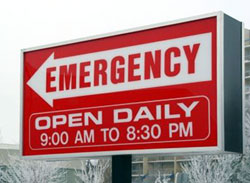
FierceHealthIT notes a new CDC study on ED overcrowding - it's getting worse.
Emergency department visits hit a new high in 2005, with more than 115 million visits, says new research from the CDC. That's a jump of five million visits over the previous year, and a substantial 20 percent increase over 10 years.
Over the same time period, the number of hospital EDs decreased more than 9 percent from 4,176 to 3,795, the CDC says. More than half of these patients (62.8 percent) were referred to a physician or clinic
for follow-up after their visit, suggesting their needs weren't critical.
The 32 page report is fuel for the American College of Emergency Physicians lobbying efforts to get congress to, "create a commission to study the ED overcrowding problem. Under the terms of the ACEP-backed bill, hospitals would have to report to HHS on how many patients are boarded in the ED, and how long they're boarded." [Patient "boarding" is the practice of placing patients in hallways, usually in the ED, where they wait for an inpatient room to become available. Patients commonly wait for hours, and sometimes more than a day, on a stretcher parked in a hallway.]
Ambulance diversion data is tracked by hospitals, regional and state hospital associations, and sometimes the state. This data is not available to the public or most state health agencies. Given how bad ED diversion is, I'm not surprised hospitals want to keep this data private - especially the worst offenders. Data on patient boarding is tracked less often by hospitals and to my knowledge, is not tracked across hospitals by associations.
Public reporting of both diversions and boarding would provide an important customer service metric and patient safety indicator and should be available to prospective patients. It is too bad that such a requirement must be forced on the industry by government.
You can download your own copy of the CDC report here (pdf).


Recent Comments